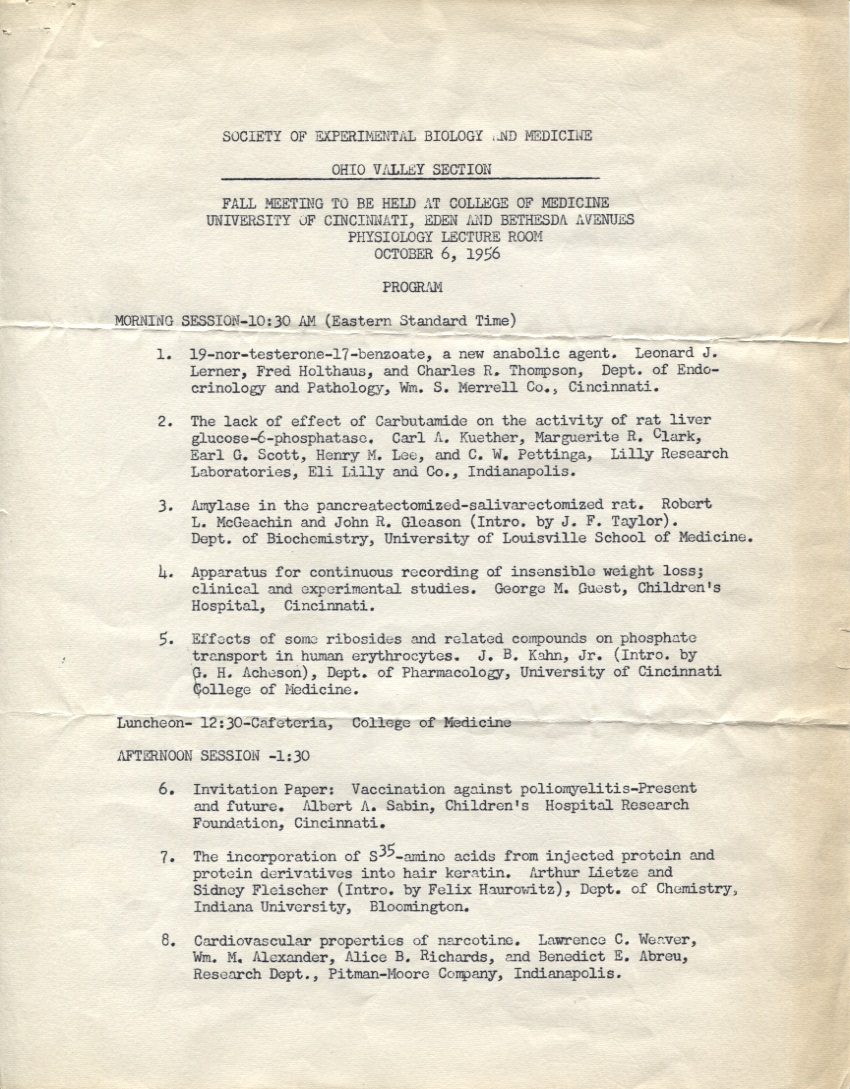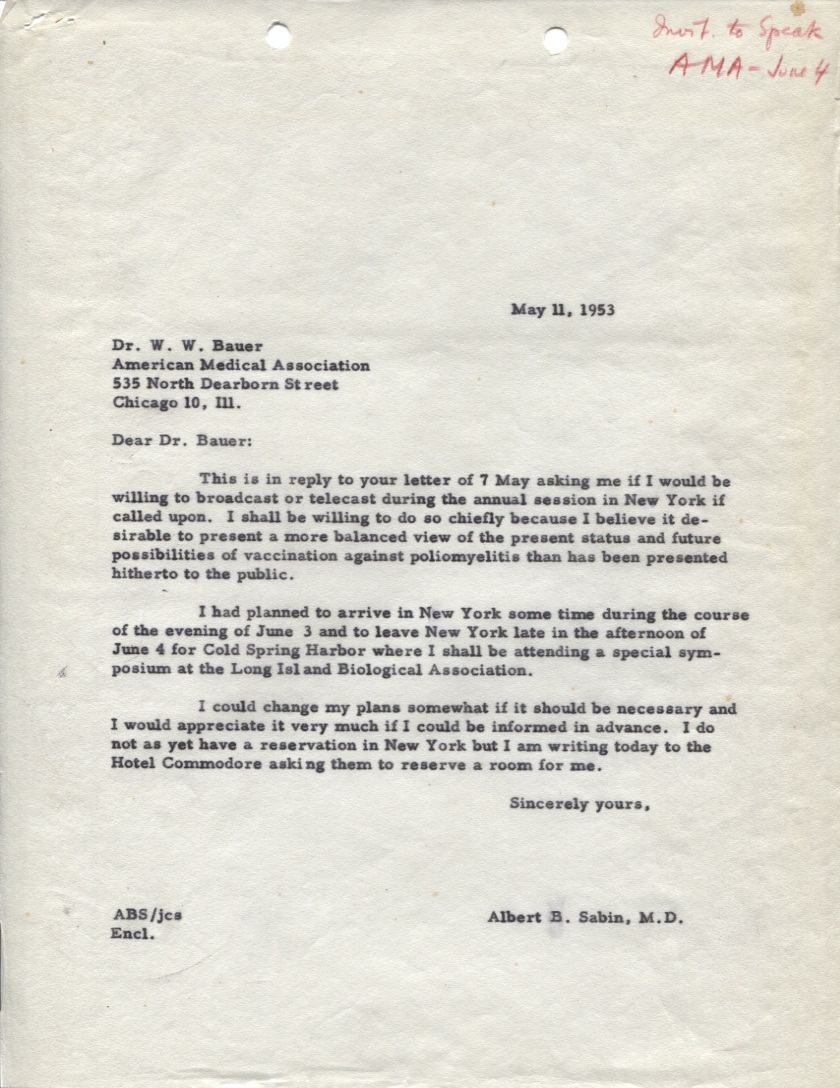 On Saturday, October 22, the 5th annual Books by the Banks: Cincinnati USA Book Festival will take place at Duke Energy Convention Center from 10:00 a.m. to 4:00 p.m. The day-long festival will feature over 100 regional and national authors, book signings, author panels, and activities for the entire family to enjoy. All events are free and open to the public.
On Saturday, October 22, the 5th annual Books by the Banks: Cincinnati USA Book Festival will take place at Duke Energy Convention Center from 10:00 a.m. to 4:00 p.m. The day-long festival will feature over 100 regional and national authors, book signings, author panels, and activities for the entire family to enjoy. All events are free and open to the public.
Author Archives: Melissa Cox Norris
Travel the World with UC Libraries: Guides, Phrase Books, and other Helpful Information to Aid You in Your Travels
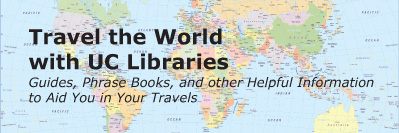 People love to travel; and UC students really love to travel. According to UC International, over the past five years, between 830 and 874 students participated in the study abroad programs annually. In addition, numerous UC faculty, students, and staff travel abroad for pleasure, business, performances, community service, and other reasons.
People love to travel; and UC students really love to travel. According to UC International, over the past five years, between 830 and 874 students participated in the study abroad programs annually. In addition, numerous UC faculty, students, and staff travel abroad for pleasure, business, performances, community service, and other reasons.
So what makes a successful travel experience? A good guidebook. UC Libraries’ print and digital collections provide excellent resources for travelers. Travel the World with UC Libraries, an exhibit currently on display on Langsam Library’s 4th floor, features guidebooks, phrase books, and websites that will aid people in their travels.
UC Libraries Present Talk from Renowned Book Conservator William Minter
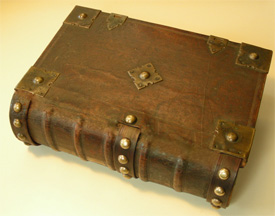 Join UC Libraries at a talk by renowned book conservator William Minter who will display and discuss the conservation treatment he did to the historic Martyrs Mirror. Scheduled for Friday, October 28th from 1:30-3:00pm in 814 Blegen, the talk is free and open to the public. A Q&A will follow and refreshments will be served.
Join UC Libraries at a talk by renowned book conservator William Minter who will display and discuss the conservation treatment he did to the historic Martyrs Mirror. Scheduled for Friday, October 28th from 1:30-3:00pm in 814 Blegen, the talk is free and open to the public. A Q&A will follow and refreshments will be served.
The Albert B. Sabin Digitization Project: October 6, 1956
A recent Wired.com blog post highlighted an important day in the development of the oral polio vaccine: October 6, 1956. On this date, Dr. Sabin gave an invited paper at the Society of Experimental Biology and Medicine meeting held in Cincinnati. His paper was called “Vaccination against Poliomyelitis – Present and Future.” It was at this meeting that Dr. Sabin reported that he had developed a polio vaccine using three attenuated poliovirus strains, which provided an “immunizing, symptomless infection” when it was administered orally to over 50 volunteers. He also announced that his live-virus polio vaccine was ready to be tested on “increasingly larger numbers of humans both in this country and in association with qualified investigators abroad.”[1]
In the days following this meeting, several newspapers covered the contents of his paper, with headlines such as:
- “Live Polio Vaccine Found – Cinti’s Dr. Sabin Develops Oral Serum,” Cincinnati Times-Star 10/6/1956
- “One-Dose Oral Vaccine Against Polio Revealed,” The Washington Post and Times Herald 10/7/1956
- “Live Vaccine Promises Lifetime Polio Immunity,” The Sunday Star (Washington D.C.) 10/7/1956
- “New, Take-by-Mouth Polio Vaccine Found,” The Miami Herald 10/7/1956
The Albert B. Sabin Digitization Project: The Sabin and Salk "Feud"
In Hal Hellman’s Greatest Feuds in Medicine: Ten of the Liveliest Disputes Ever, one chapter is devoted to the dispute between Dr. Albert Sabin and Dr. Jonas Salk. Hellman chose this dispute as one of the ten that had “some special drama or scientific interest, that in some way influenced the future course of medical science, or that have had repercussions in our own day” (p. xiii). The chapter briefly discusses the history of polio and the development of the two vaccines, as well as the aftermath. Hellman argued that “Salk deserved better treatment” from his fellow scientists (p. 141). However, he also wrote, “But we must remember that in the Sabin-Salk feud there is no real victor” (p. 140).
In his analysis of the Sabin-Salk “feud,” Hellman mentions an incident in early 1953, where information about the killed-virus vaccine was leaked to the public prior to the publication of an article in the Journal of the American Medical Association. The newspaper articles about Salk’s vaccine gave the public hope in the fight against polio. On the other hand, these same newspaper articles painted Salk as a “glory hound” in the eyes of his fellow scientists (p. 136). Continue reading
Public Library Awarded a LSTA Grant to Create a Joint Conservation Lab with UC Libraries
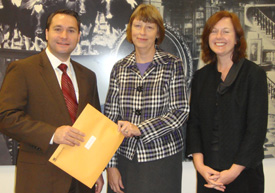
Missy Lodge (center), Associate State Librarian for Library Development, State Library of Ohio, awarding the grant to Jason Buydos, Assistant Director - Support Services, Public Library of Cincinnati and Hamilton County; and Holly Prochaska, Head, Preservation Services and of the Geology-Mathematics-Physics Library, University of Cincinnati Libraries
The Public Library of Cincinnati and Hamilton County was awarded a $81,012 Library Services and Technology Act (LSTA) grant from the State Library of Ohio to establish a joint Conservation Lab with the University of Cincinnati Libraries for the preservation and protection of rare and heavily used materials.
Fall LIFE OF THE MIND Lecture Series Kicks Off October 18
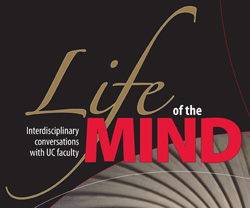 The fall “Life of the Mind” lecture series will kick off Tuesday, October 18 from 3:30-5pm in the Russell C. Myers Alumni Center. Free and open to the UC community and public, “Life of the Mind” features interdisciplinary conversations with UC faculty around a one-word theme followed by audience Q&A. The fall “Life of the Mind” theme is “War.”
The fall “Life of the Mind” lecture series will kick off Tuesday, October 18 from 3:30-5pm in the Russell C. Myers Alumni Center. Free and open to the UC community and public, “Life of the Mind” features interdisciplinary conversations with UC faculty around a one-word theme followed by audience Q&A. The fall “Life of the Mind” theme is “War.”
SearchOhio: A New Resource for University of Cincinnati Libraries Users
Beginning October 3, University of Cincinnati Libraries users will have access to a new resource for borrowing materials via SearchOhio. SearchOhio is a consortium of Ohio public libraries sharing materials amongst their patrons, similar to how OhioLINK facilitates the sharing of resources between many of Ohio’s colleges and universities. UC students, staff and faculty will be able to utilize SearchOhio to access books and more that they cannot first obtain through the University of Cincinnati Libraries or OhioLINK. Users will find a link to SearchOhio in their search results when they use the OhioLINK catalog.
The Albert B. Sabin Digitization Project: The National Foundation for Infantile Paralysis
The National Foundation for Infantile Paralysis (now known as the March of Dimes) played an important role in the research and development of Dr. Sabin’s oral polio vaccine. According to the March of Dimes, Dr. Sabin received around $1.5 million to support his research on polio from 1952 to 1961. Our collection has a couple of boxes labeled “NFIP,” as well as letters scattered throughout the collection from notables such as Basil O’Connor, Donald W. Gudakunst, and Thomas Rivers. I thought I’d share a little about the NFIP and some material we have.
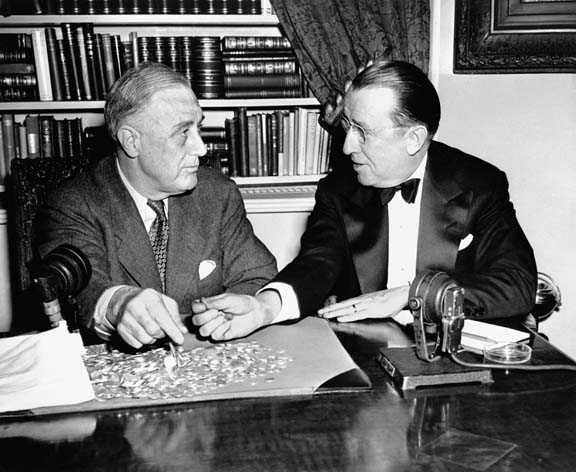
Photograph of President Franklin Roosevelt and Mr. Basil O’Connor, 1944. Courtesy of the March of Dimes.
Founded in 1938 by President Franklin D. Roosevelt, the National Foundation for Infantile Paralysis’s mission was to “‘lead, direct, and unify’ the fight against polio, a paralyzing viral disease.” The leader of this organization was Basil O’Connor, who was president for over 30 years. (Both of these men can be seen in the photo to the right.) The NFIP was created to raise funds for poliomyelitis research for every stage of the disease, unlike the Georgia Warm Springs Foundation (also founded by Roosevelt), which worked to improve the quality of life of those who had already been affected by polio. One of the major NFIP fundraisers was the “March of Dimes,” which urged all people to send at least a dime to support President Roosevelt in the fight against polio. Researchers such as Dr. Sabin and Dr. Jonas Salk benefited from fundraising efforts such as this because of the grant money they received from the NFIP. Over the years since the NFIP was founded, its name has changed to the March of Dimes, and its mission has evolved to improve the health of babies by preventing birth defects, premature birth, and infant mortality. (See the History of the March of Dimes for more information.) Continue reading
Are You A UCGuest and Want to Use the Internet?
The University of Cincinnati provides a wireless network that allows visitors who are not associated with UC and do not have credentials allowing access to our wireless network to connect to a “UCGuest” network. The “UCGuest” access allows visitors to view the Libraries website and search the Library Catalog.
When guests search for internet access, they should select the “UCGuest” option. No log on information is needed, but they must review and accept UCIT’s terms of use before a connection will be allowed.
More information is available on UCit’s website.

